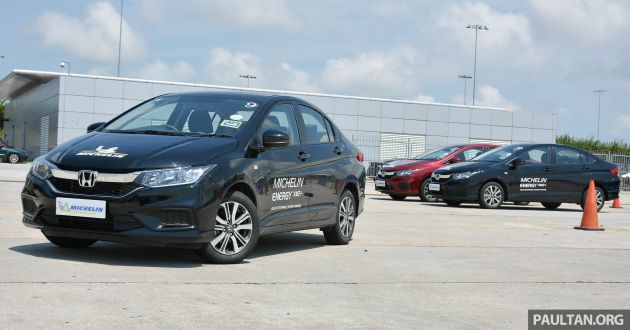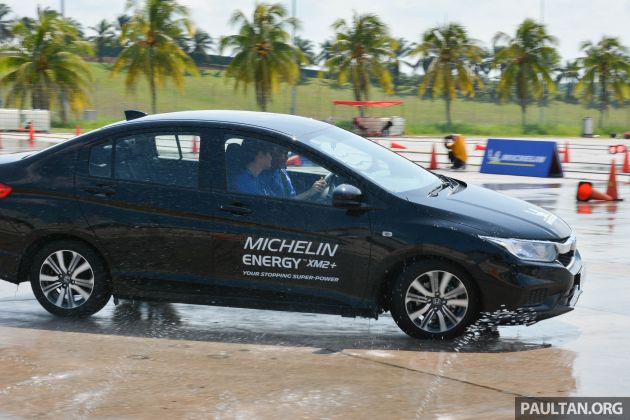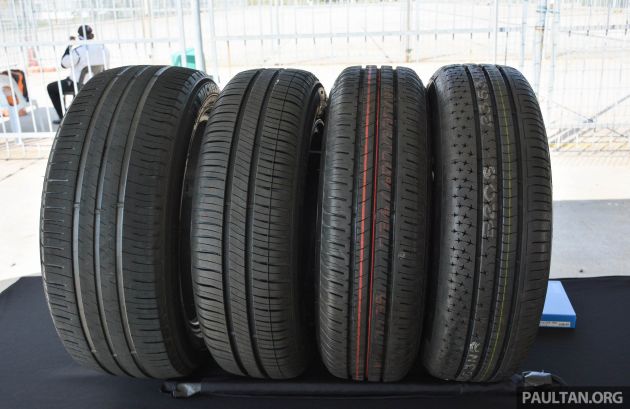You’ve probably heard the idiom “the proof is in the pudding” before, which means the end result is the mark of the success or failure of one’s efforts or planning. Well, Michelin Malaysia is keen to demonstrate that its new Energy XM2+ tyre perfectly encapsulates the saying, as the company promises improved performance from the previous XM2 it replaces.
With the XM2+, the company is claiming greater durability and shorter wet weather braking distances when compared to offerings from close competitors, and this is even when the tyres are worn.
These are bold claims, and to ensure the XM2+ conforms to another idiom – walk the talk – we were given the chance to sample the XM2+ in various scenarios following the launch at the Sepang International Circuit.
To ensure a level playing field that only factors in the performance of the tyre is evaluated, every single vehicle used on the day was a low-mileage Honda City of almost identical condition.
The only differences between the cars were the tyre models fitted, with a mix of brand-new and worn-down rubbers – the latter being about 15% of tread life left, or really close to the tread wear indicator.
The first test of the day was to navigate a small gymkhana course, which has been properly drenched to mimic the kind of road conditions we usually get in our climate. For this exercise, we drove three cars, with two of them being fitted with worn XM2+ and Continental ComfortContact CC6 tyres, while the third car got a new set of XM2+.
On our runs (two in each car), where we maintained a consistent pace of around 40-50 km/h, we discovered that the wet cornering performance didn’t differ drastically between the XM2+ and CC6.
Both tyres dispersed water well enough to ensure there was grip, and short of forcing the issue by way of the accelerator pedal, allowed for easy manoeuvring without understeer creeping in.
With the XM2+ however, it did feel like the car was capable of turning in a little sharper by comparison, which could be attributed to the larger contact area resulting from the new formulation of the tyre’s full-silica compound. A run with a fresh set of XM2+ did give a slightly “floaty feeling” but this could be due to the tyre not being worn in a little beforehand.
According to Michelin, the new formulation provides higher flexibility, allowing for a larger tyre-ground contact area in micro-scale. With this, the tyre is better able to better fill in the incredibly tiny gaps that the human eye can’t see on the road surface, which translates to better grip.
The new compound also bonds stronger from filler to filler, and this molecular bonding is said to minimise wear and extend longevity by up to 25% against competitors. Of course, we aren’t able to test this claim during our short stint, so your mileage may vary depending on usage.
The effects of a larger contact area is more evident in our second test, a braking test from 80 km/h to a dead stop, also on a wet surface. With some figures for context, the XM2+ is claimed to provide a braking distance of around 30.4-30.5 metres, regardless of them being worn or new.
By comparison, the other tyres tested here – CC6 and Bridgestone Ecopia EP300 – are said to have longer braking distances of up to 35.2 metres when new, and up to 40.9 metres when worn. The numbers from this test show the XM2+ stops five metres earlier when new compared to its competitors, and a full 10 metres when worn. On its marketing material, Michelin says its offering offers shorter wet braking distances by 1.5 metres when new, and by 2.6 metres when tested by an independent company – TUV Rheinland Thailand.
With VBox data loggers fitted on each car, and after repeated attempts, the results we (and other media present) obtained were consistent with the claims made, as the cars with XM2+ had shorter braking distances compared to its competitors. This is even when any margin of error resulting from driver input is taken into consideration, which is certainly an impressive feat.
As explained by a Michelin technical engineer, the XM2+ with its softer compound, allows for more tyre-ground contact area that is beneficial when braking in the wet. By using a durometer – a device used to measure material hardness – we found out that the rubber compound of the XM2+ registered a 61.5 on the Shore A scale (less indicates a softer material) – the competitor tyres had figures closer to the 70 mark.
While the engineer did concede a softer compound can wear faster, the gains from wet braking performance took priority when it came to designing the XM2+. With the volatility involved in driving, a metre more or less could be the difference between you stopping safely, or hitting an object in front of you during an emergency braking situation.
Other characteristics that assist in this regard is the compound’s ability to maintain the tyre’s tread and siping patterns even when the tyre has been worned down, ensuring water is channeled away efficiently. The tyre’s alternating bridging also reinforces the rigidity of the tread blocks for better grip and mileage – larger profile tyres have three grooves instead of two.
Unfortunately, there’s no way for us to test how the XM2+ performs when it comes to ride comfort and road noise, but we were told that the company maintained the same levels as what the XM2 already had, which is already a positive previously.
All in all, the XM2+ certainly lives up to the company’s claims as we found out, and would be a welcome upgrade for many mass-market car models like the City, Volkswagen Polo, Toyota Vios, Perodua Myvi, Honda Jazz and many others.
The XM2+ is now available at all Tyreplus and Michelin authorised dealers across Malaysia in 32 sizes, ranging from 14 to 16 inches in diameter, with prices starting from RM200.
Source: Read Full Article







